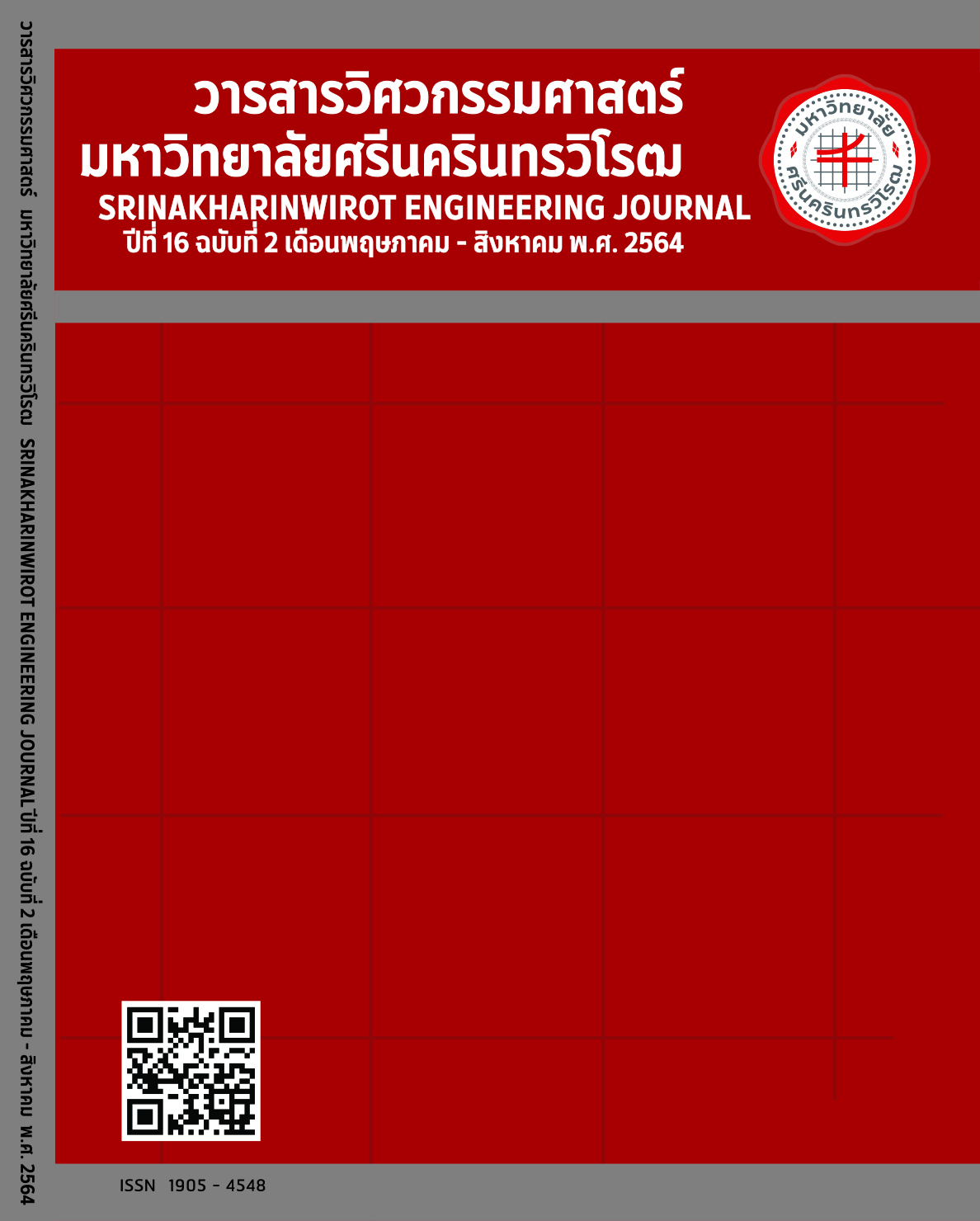Chloride Penetration Resistance of Concrete with Wet Fly Ash
Main Article Content
Abstract
This research aims to study the chloride penetration resistance and compressive strength of concrete containing fly ash (FA). The fly ash was used as a partially replacement material of binder in the form of wet fly ash (WFA) and dry fly ash (DFA) at the percentage replacement of 20%, 40% and 60%. The water to binder ratio (w/b) was kept at the ratios of 0.50 and 0.60. To produce the WFA, FA was mixed with the water at the water to FA ratio (w/f) of 0.60, then cured for 30 days before used in the mixing of concrete. The rapid chloride penetration resistance, bulk chloride diffusion resistance and compressive strength of the concrete with WFA and DFA were conducted. From the experimental results, it was found that chloride penetration resistance of concrete containing WFA and DFA with the percentage replacement of 40% was the highest. The chloride penetration resistance of concrete with WFA was higher than that with DFA. The compressive strength of concrete containing WFA and DFA with the percentage replacement of 20% was higher than cement-only concrete. The compressive strength of concrete with WFA was higher than that with DFA.
Article Details

This work is licensed under a Creative Commons Attribution-NonCommercial-NoDerivatives 4.0 International License.
Copyright belongs to Srinakharinwirot University Engineering Journal
References
W. Saengsoy, T. B. T. Nguyen, and S. Tangtermsirikul, “A study on basic properties of mortar made with wet fly ash,” in proc. of the 6th Int. Conf. of ACF, Seoul, Korea, 2014, pp. 949-955.
T. B. T. Nguyen, W. Saengsoy and S. Tangtermsirikul, “Effect of initial moisture of wet fly ash on the workability and compressive strength of mortar and concrete,” Constr. Build. Mater., vol. 183, pp. 408-416, September 2018.
American Society for Testing and Materials, ASTM C618-19, Standard specification for coal fly ash and raw or calcined natural pozzolan for use in concrete, ASTM International, West Conshohocken, PA, 2019.
R. Cheerarot and C. Jaturapitakkul, “A study of disposed fly ash from landfill to replace Portland cement,” Wast. Manag., vol. 24(7), pp. 701–709, March 2004.
S. A. Haldive and A. R. Kambekar, “Experimental study on combined effect of fly ash and pond ash on strength and durability of concrete,” Int. J. Sci. Eng. Res, vol. 4(5), pp. 81–86, May 2013.
B. Andrew and P. G. Aceves, “The use of non-commercial fly ash in roller compacted concrete structures,” in World of Coal Ash Conf., Denver, CO, USA, 2011, pp. 1-4.
American Society for Testing Materials, ASTM 1202-97, Standard test method for electrical indication of concrete’s ability to resist chloride ion penetration, ASTM International, West Conshohocken, PA, 2004.
American Society for Testing and Materials, ASTM 1556, Standard test method for determining the apparent chloride diffusion coefficient of cementitious mixtures by bulk diffusion, ASTM International, West Conshohocken, PA, 2004.
American Society for Testing and Materials, ASTM C1152, Standard test method for acid-soluble chloride in mortar and concrete, ASTM International, West Conshohocken, PA, 2004.
British Standard, BS 1881-116, Method for determination of compressive strength of concrete cubes, 1983.
T. Sumranwanich and S. Tangtermsirikul, “A model for predicting time-dependent chloride binding capacity of cement-fly ash cementitious system,” Mat. Struct., vol. 37(6), pp. 387–396, July 2004.
J. Liu, G. Ou, Q. Qiu, X. Chen, J. Hong and F. Xing, “Chloride transport and microstructure of concrete with/without fly ash under atmospheric chloride condition,” Constr. Build. Mater., vol. 146, pp. 493–501, August 2017.
L. Prak, T. Sumranwanich and S. Tangtermsirikul, “Time-dependent model for predicting chloride binding capacity of concrete with crystalline material,” J. Mater. Civ. Eng., vol. 33(2), pp. 04020473, February 2021.
I. Sirisawat, W. Saengsoy, L. Baingam, P. Krammart and S. Tangtermsirikul, “Durability and testing of mortar with interground fly ash and limestone cements in sulfate solutions,” Constr. Build. Mater., vol. 64, pp. 39-46, August 2014.
J. Feng, J. Sun and P. Yan, “The influence of ground fly ash on cement hydration and mechanical property of mortar,” Adv. Civ. Eng., vol. 2018, pp. 1–7, May 2018.
L. Wang, K. Uji and A. Ueno, “Evaluation on reaction efficiency coefficient of fly ash based on threshold value of effective replacement ratio,” Cement Sci. Con. Tech., vol. 71(1), pp. 645–652, March 2018.
L. Prak and T. Sumranwanich, “Chloride binding capacity and water absorption of mortar containing fly ash, limestone powder, and expansive additive,” J. Eng. RMUTT, vol. 18(2), pp. 133-144, December 2020.


